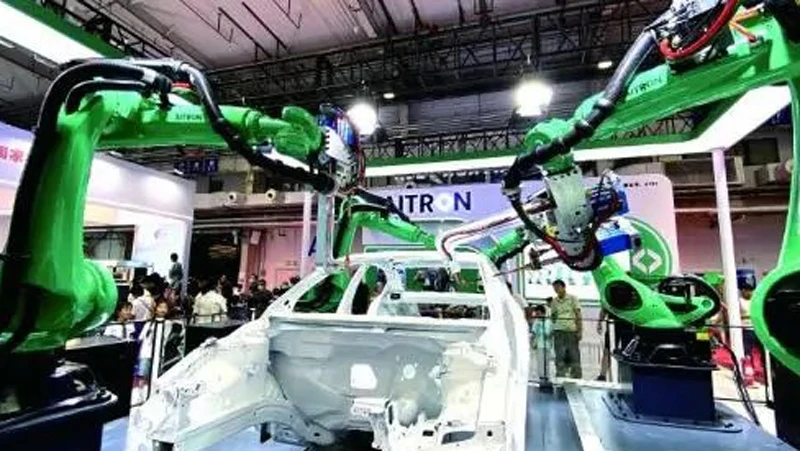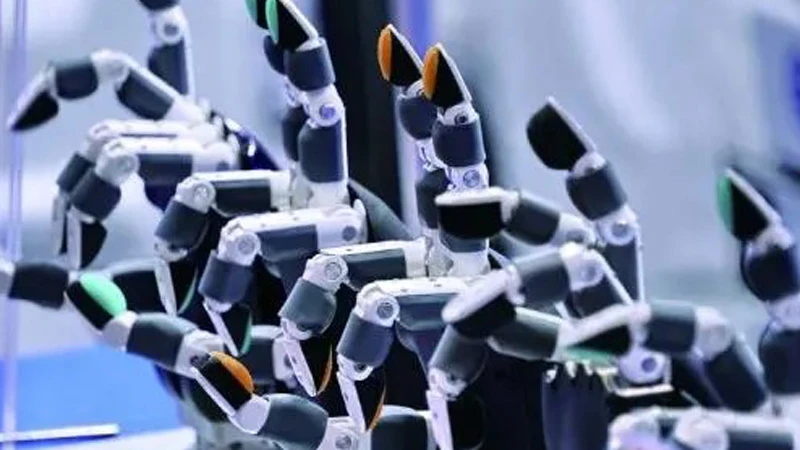Chinese robots are gaining momentum in international markets as the global robotics industry expands. At the recently concluded 2024 World Robot Conference, over 600 innovative robot products were showcased, highlighting China's pivotal role in shaping the future of robotics. From industrial applications to household innovations, Chinese robots are moving beyond domestic use, spearheading growth in foreign trade, especially in the Yangtze River Delta region.
The National Bureau of Statistics reports that from January to July 2024, China produced over 300,000 sets of industrial robots, with a remarkable 19.7% year-on-year growth in July alone. The strong growth in production has been accompanied by a significant increase in robot exports, with the Yangtze River Delta region contributing more than half of the nation's total robotic exports.

Yangtze River Delta Leading the Robotic Export Boom
The Yangtze River Delta, a crucial manufacturing hub, has emerged as a powerhouse in China's robotics exports. Data from Shanghai Customs revealed that in the first seven months of 2024, the region's total trade value reached 9.1 trillion yuan, up 5.8% year-on-year, with exports of industrial robots growing by 26.6% to 20.5 billion yuan. This accounts for more than 50% of China's total robot exports.
China's robotics companies are expanding their global footprint, with many focusing on developing international markets. CloudDeep, a robotics company specializing in embodied intelligence, has seen significant growth in its overseas business. In the first quarter of 2024, they secured contracts from Singapore, South Korea, the United States, and Germany. Their quadruped robots are already being deployed in Singapore's national power grid project, marking the first time Chinese robots are used in the international electrical sector.
Major cities in the Yangtze River Delta, such as Shanghai, Jiangsu, and Zhejiang, are leading the way in robotic exports. Shanghai alone contributes 21.8% of the nation's total robotic exports, followed by Jiangsu 14.4%, Zhejiang 7.7%, and Anhui 5.6%. According to the China Academy of Information and Communications Technology, the region's mature ecosystem, abundant resources, and favourable policies have created an ideal environment for the growth of robotic industries. Established companies and startups benefit from the solid industrial support and diverse application scenarios available in the region.
Robotic Production Soars Amid Global Demand
China's industrial robotics production has skyrocketed over the past eight years. From 2015 to 2022, the country's annual production of industrial robots grew from 33,000 to 443,000 units, representing a 12-fold increase. In 2023, China claimed 52.45% of the global industrial robotics market share, surpassing foreign brands for the first time in sales volume.
The Yangtze River Delta has been a major driver of this growth. For instance, Yuyao Robot Smart Valley (余姚机器人智谷小镇) in Ningbo , Zhejiang, was established in 2015 to focus on advanced equipment and core components for intelligent robots. Today, it has developed into a hub of robotic innovation. In the first half of 2024 alone, over 8,000 industrial robots, including robotic arms and manipulators, were exported from Yuyao, generating export revenues of 27 million yuan, a more than 50% year-on-year increase.
The region is home to many other robotic industrial parks, such as Zhangjiang Robotics Valley (张江机器人谷) in Shanghai, Wuzhong Robotics Industrial Park (吴中机器人产业园) in Suzhou, and Wuhu Robotics Industry Cluster (芜湖机器人产业集聚区) in Anhui. These parks have fostered the rapid growth of China's robotics industry, helping transform it into a new engine for economic development.
According to data from Qichacha (企查查), China now has over 716,700 registered robotics-related enterprises. Jiangsu is home to 92,600 companies, ranking second only to Guangdong. Zhejiang, Shanghai, and Anhui follow closely behind, collectively accounting for 30% of the country's robotics businesses. This cluster of enterprises has helped the Yangtze River Delta become the centre of China's robot export boom.
China's Robotics Industry Gears Up for a Global Future
As China continues to lead in robotic production and exports, its global influence is set to expand. However, experts emphasize that Chinese robotics companies must carefully navigate the international market. CloudDeep's AI director, Ling Ying (凌颖), notes that although domestic sales and international agencies have driven China's robot exports thus far, the future will require more robust strategies.
"AI advancements will make robots smarter and more adaptable, but companies must also be vigilant about data compliance risks when expanding overseas," says Ling.
The global demand for Chinese robots is expected to grow as companies worldwide look for cost-effective, innovative solutions. Chinese robotic manufacturers, especially those in the Yangtze River Delta, are poised to continue leading this charge, propelling domestic and international trade to new heights. By leveraging their manufacturing capabilities, AI technologies, and competitive pricing, Chinese robots are transforming industries and reshaping the global robotics landscape.
In conclusion, with strong government support, advanced technological infrastructure, and a thriving industrial ecosystem, China's robotics industry is set to continue its upward trajectory. As more Chinese companies focus on innovation and expanding their global footprint, the country's role as a leader in the international robotics revolution will only strengthen.


